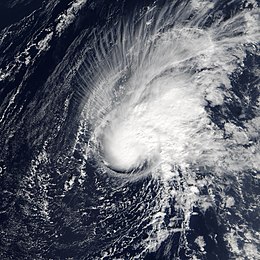Tropical Storm Zeta
| Tropical storm (SSHWS/NWS) | |

Tropical Storm Zeta at peak intensity in the open Atlantic on January 3
|
|
| Formed | December 30, 2005 |
|---|---|
| Dissipated | January 7, 2006 |
| (Remnant low after January 6) | |
| Highest winds |
1-minute sustained: 65 mph (100 km/h) |
| Lowest pressure | 994 mbar (hPa); 29.35 inHg |
| Fatalities | None reported |
| Damage | None |
| Areas affected | No land areas |
| Part of the 2005 Atlantic hurricane season | |
Tropical Storm Zeta was a late-developing tropical storm over the central Atlantic that formed after the 2005 Atlantic hurricane season had officially ended (on November 30) and continued into January 2006. Becoming a tropical depression at approximately midnight on December 30 (UTC), it became the record-breaking thirtieth tropical cyclone of the 2005 Atlantic hurricane season and after intensifying into Tropical Storm Zeta six hours later, it became the season's twenty-seventh named storm. Zeta was one of only two Atlantic tropical cyclones to span two calendar years (the other being Hurricane Alice in 1954–55).
Zeta originated from an area of low pressure on December 29, which previously developed within an upper-level trough. After becoming a tropical storm, the National Hurricane Center continually predicted it would weaken rapidly. Like the previous tropical cyclone, Hurricane Epsilon, Zeta defied these predictions. The storm reached its peak strength on January 2, 2006 before finally dissipating on January 6. As Zeta never approached land there was no impact from the storm other than minor shipping problems. Several ships encountered the storm, and several crews in the 2005 Atlantic Rowing Race were affected by rough seas and high winds.
Tropical Storm Zeta originated from an upper-level trough that interacted with a weakening frontal system in late-December 2005. By December 28, the trough had developed into a low pressure area roughly 750 mi (1,210 km) west-northwest of the Cape Verde Islands. The following day, a low-level circulation developed and convective activity began to increase around the low. By December 30, sufficient shower and thunderstorm activity had developed for the National Hurricane Center (NHC) to classify it as a tropical cyclone. Over the following several hours, convective banding developed around the storm's center and by 0600 UTC, the depression intensified into Tropical Storm Zeta, the record 28th tropical or subtropical cyclone to form during the 2005 Atlantic hurricane season. Operationally, however, the NHC did not begin issuing advisories on Zeta until 1700 UTC. Traveling slowly northwestward in response to a mid-level low to the southwest, the storm gradually intensified in a region of favorable anticyclonic outflow.
...
Wikipedia
